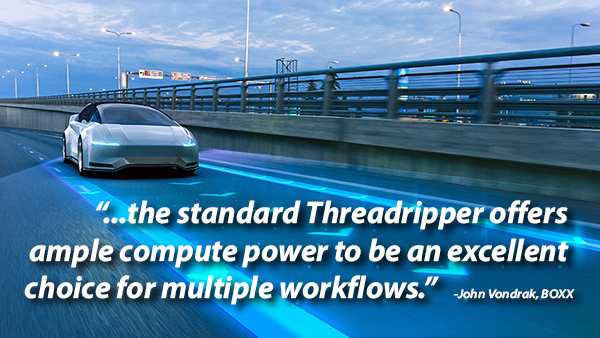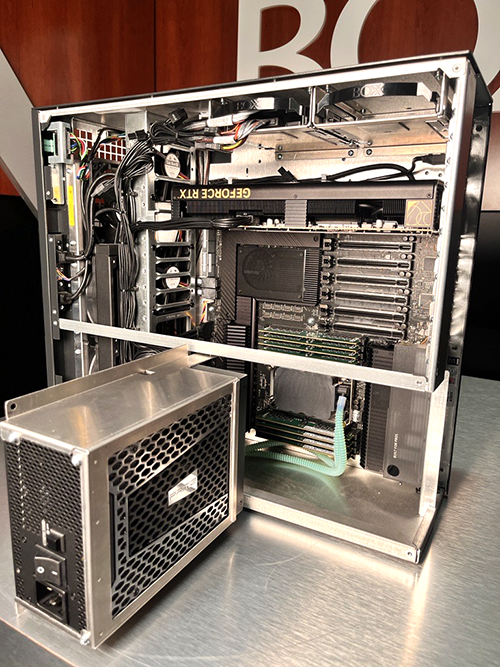
Published November 27, 2023 by John Vondrak
Tags: CPU GPU AMD Ryzen Threadripper 3Ds Max AVID Cinema 4D Maya Revit V-Ray AI, Deep Learning & Machine Learning
Threadripper vs. Threadripper PRO: What’s the Difference?
If you read my previous blog discussing the importance of the new AMD Ryzen™ Threadripper™ PRO 7000 WX-Series processors, you’ll recall that I briefly differentiated it from the also new AMD Ryzen™ Threadripper™ standard processor. In hindsight, the differences (and similarities) between the two CPUs merit a deeper dive.
 I’ve seen the standard Threadripper processor referred to as “consumer grade,” while Threadripper PRO is for the professional market. Somewhat true, but I take umbrage with the term “consumer grade” as it gives short shrift to an exceptional CPU that provides excellent performance for a variety of professional applications like Avid, 3ds Max, Maya, Cinema 4D, V-Ray and more. Besides, a 64-core processor running up to 5.1GHz should never be designated as merely consumer grade. Since I’ve tipped my hand by getting into specs, let’s dive in.
I’ve seen the standard Threadripper processor referred to as “consumer grade,” while Threadripper PRO is for the professional market. Somewhat true, but I take umbrage with the term “consumer grade” as it gives short shrift to an exceptional CPU that provides excellent performance for a variety of professional applications like Avid, 3ds Max, Maya, Cinema 4D, V-Ray and more. Besides, a 64-core processor running up to 5.1GHz should never be designated as merely consumer grade. Since I’ve tipped my hand by getting into specs, let’s dive in.
But first, in the interest of blog space (and since BOXX is renowned for only using enterprise class components) I’ll relegate this discussion to the top of the line Threadripper 7980X CPU vs. the top of the line Threadripper PRO 7995WX. For starters, both are built with the heralded AMD “Zen 4” architecture which is designed to optimize content creation.
CPU Cores
In regard to CPU frequency, both CPUs are capable of reaching speeds up to 5.1GHz, unless of course you’re BOXX, where our performance-tuned Threadripper CPUs inside the APEXX T3 and T4 workstations reach 5.3GHz.
The big difference? It’s in the cores. For Threadripper, the maximum is 64 cores/128 threads—still an outstanding amount to optimize multi-threaded applications. Threadripper PRO, on the other hand, maxes out at a mind-blowing 96 cores/192 threads to tackle any demanding workflow imaginable like rendering, complex simulation, generative design, and software compilation tasks. In fact, 96 is the most cores available from any CPU on the market.
TDP
Another similarity is the thermal design power (TDP) number which tells you the maximum heat a CPU uses in watts. Both Threadripper and Threadripper PRO come in at 350W. More watts equals better performance, but that also means higher temperatures and more power consumption, and that’s a rock solid argument for choosing a workstation equipped with liquid cooling—like BOXX.
Cache
Cache memory stores frequently accessed data so the CPU doesn’t have to access the main memory, which is much slower. The faster speed enhances application performance. Standard Threadripper provides 320MB, but PRO tops that with 480MB (384MB of L3 cache).
Motherboard
 Both procs offer a broad range of motherboard features, and this is where (like core count) the differences are more pronounced. The Threadripper 7000 Series with the AMD TRX50 chipset offers 4-channel memory support and up to 1 TB DDR5-5200 RDIMM, Threadripper PRO 7000 WX-Series with the AMD WRX90 chipset doubles that with 8-channel memory support and up to 2TB DDR5-5200 RDIMM. Those eight channels for DDR-5 memory, along with the aforementioned 384MB of L3 cache, excel for any applications that require high memory capacity and bandwidth.
Both procs offer a broad range of motherboard features, and this is where (like core count) the differences are more pronounced. The Threadripper 7000 Series with the AMD TRX50 chipset offers 4-channel memory support and up to 1 TB DDR5-5200 RDIMM, Threadripper PRO 7000 WX-Series with the AMD WRX90 chipset doubles that with 8-channel memory support and up to 2TB DDR5-5200 RDIMM. Those eight channels for DDR-5 memory, along with the aforementioned 384MB of L3 cache, excel for any applications that require high memory capacity and bandwidth.
As for PCIe lanes, standard Threadripper has a total of 92, with up to 48 PCIe 5.0 lanes, but Threadripper PRO provides 148 PCIe lanes with up to 128 PCIe 5.0 lanes. This enables you to add more peripheral devices.
Both processors support overclocking, but with Threadripper PRO, that comes with one caveat—it’s not available on OEM systems. However, Threadripper PRO does includes a list of AMD security features:
AMD PRO Manageability
AMD PRO Business Ready support
AMD Secure Processor
AMD Shadow Stack
AMD Memory Guard
…while the standard Threadripper does not.
GPU Support
Both AMD and NVIDIA offer elite GPU options for both Threadripper and Threadripper PRO-powered workstations.
Conclusion
So which is ideal for you? The short answer is that it depends on your applications and workflow. As I mentioned at the outset, the standard Threadripper offers ample compute power to be an excellent choice for multiple workflows. However, if your work involves a lot of rendering, complex simulation, generative design, software compilation tasks, and the like, who, for example, wouldn’t love to experience up to two times faster performance in V-Ray?
I already mentioned the sub compact APEXX T3 and the APEXX T4 tower powered by AMD Ryzen Threadripper 7000 Series processors, but BOXX also has the APEXX T4 PRO desk side tower and RAXX T3 PRO rackmount system both equipped with the AMD Ryzen Threadripper PRO 7000 WX-Series.
Those are the options, so if you need help with your Threadripper decision, I highly advise you contact a BOXX performance specialist via online chat at boxx.com or by calling 877.877.BOXX.
